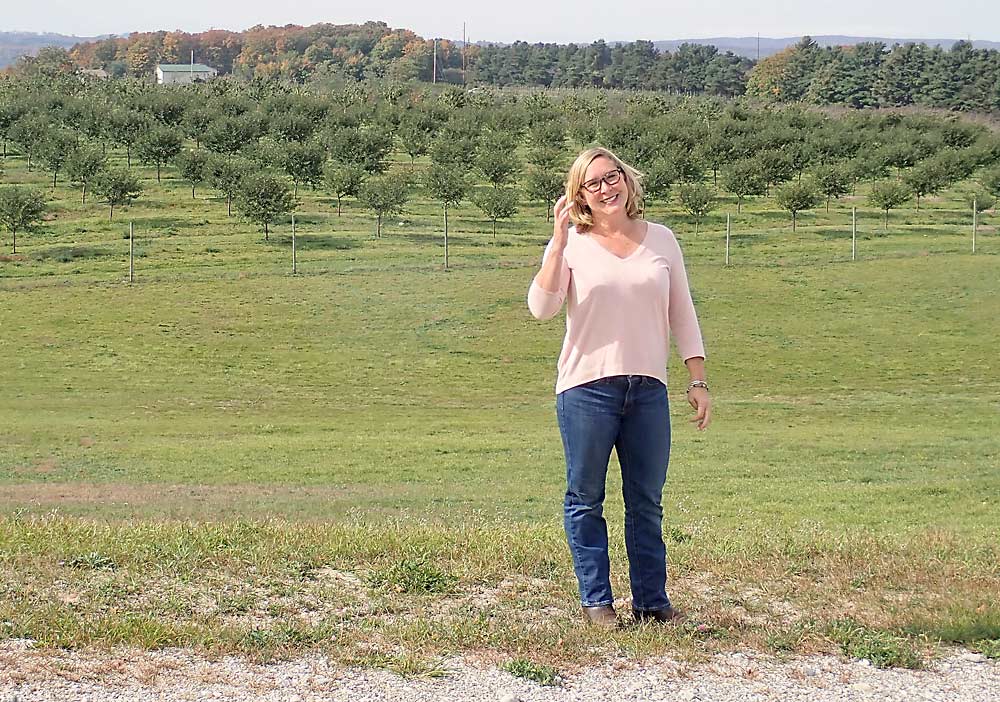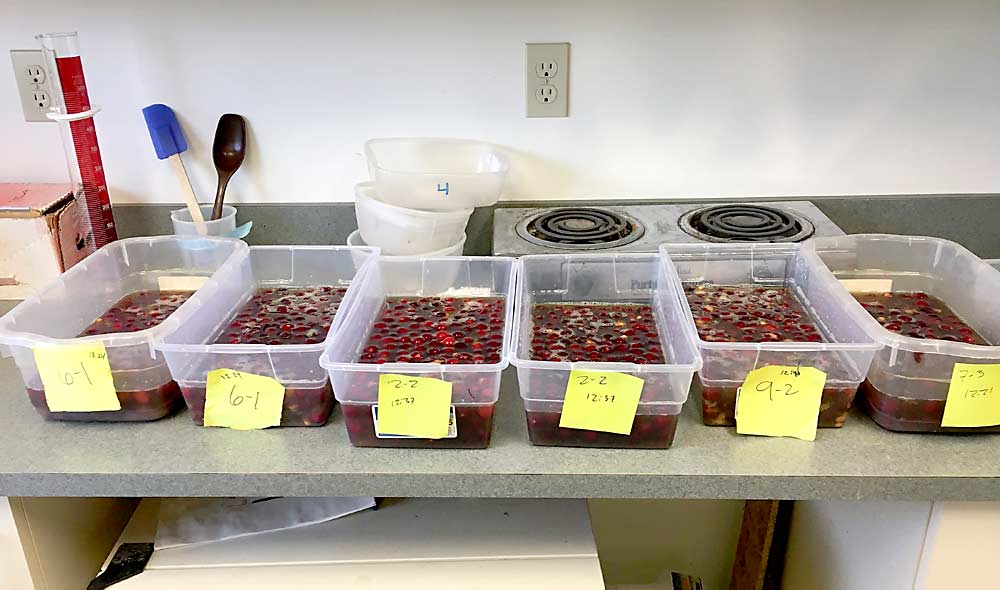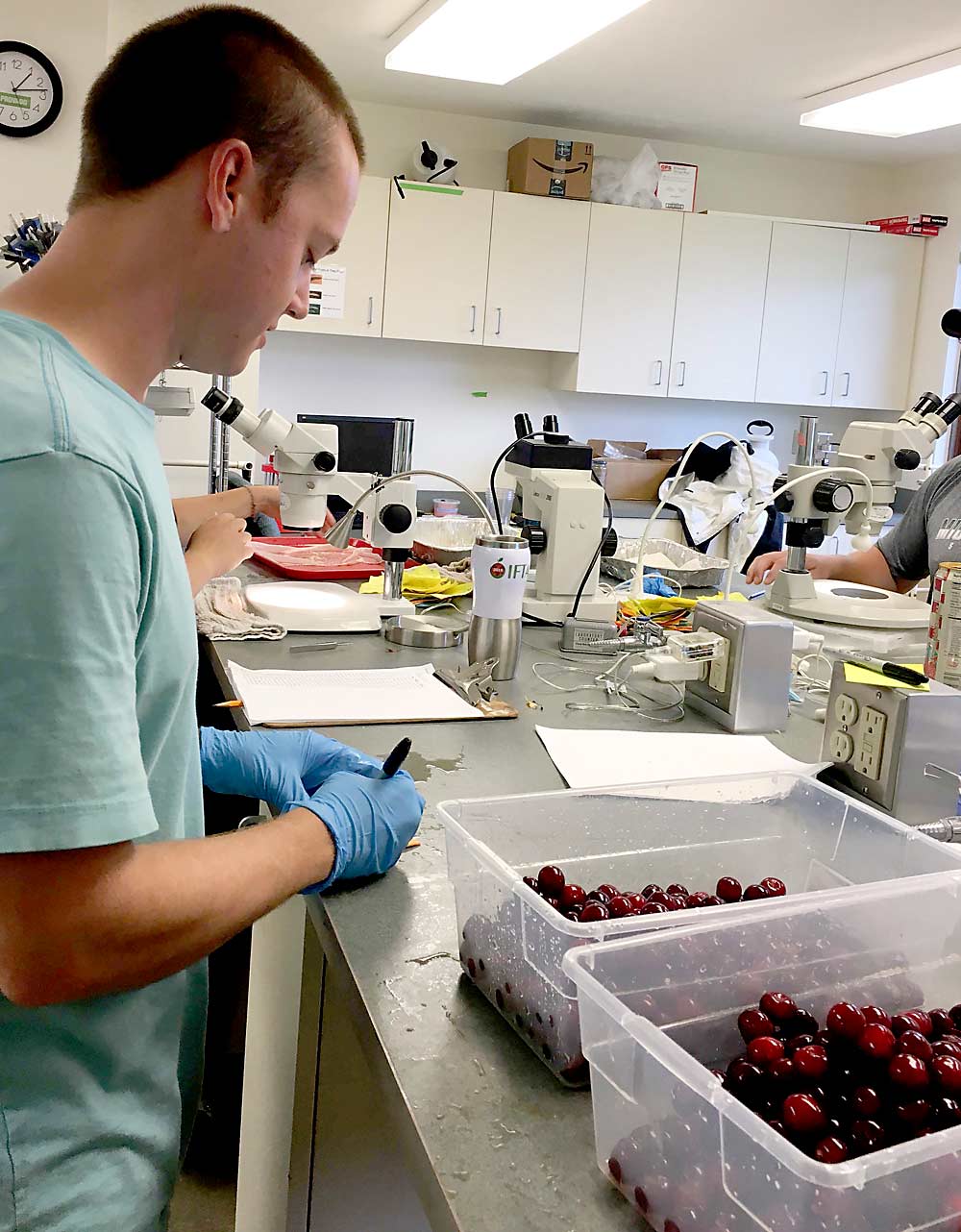
Michigan State University extension specialist Nikki Rothwell recommends growers make their orchards less hospitable to spotted wing drosophila by pruning out six to 10 large limbs from the trees and keeping between-row areas cut short. These recommendations are based on research showing that higher temperatures and lower humidity may discourage SWD. (Leslie Mertz/for Good Fruit Grower)
With a prune here and a mow there, Michigan tart cherry growers may be able to make their orchards less attractive to spotted wing drosophila (SWD) — and potentially lessen the damage from these vexing fruit flies, according to Michigan State University research.
When SWD first arrived in Michigan in 2010, most people thought tart cherries were safe because the harvest would come well before annual SWD numbers rose to problem levels.
That wasn’t the case.
SWD populations swelled ever earlier in subsequent years and began hitting tart cherries hard by 2016. In fact, both 2016 and 2017 saw 20 percent crop losses to SWD, said Nikki Rothwell, coordinator of the Northwest Michigan Horticulture Research Center in Traverse City.
At that time, MSU extension agents and researchers had been focusing mainly on finding pesticides to battle SWD, “but as we talked to growers and saw how exhausting it was to spend more time on the sprayers, constantly worry about SWD, and still have infested fruit, we felt we really had to come up with a more holistic approach to controlling these pests,” she said.
Rothwell was aware of studies in berry fields that showed SWD left the crop in the heat of the day, retreating to cooler and more humid adjacent woodlands.
“So I thought that what might be happening in tart cherry orchards is that SWD don’t need to move outside of the system,” she said. “If you think about it, these are big trees grown on standard rootstocks, and they have a beautiful canopy where the relative humidity stays pretty high and where there’s some shade, so the temperature is lower.”
In other words, SWD would have no reason to leave.

Tart cherries are held in containers with a brown sugar and water solution for 15 minutes and are then strained and checked under a microscope for SWD larvae. (Courtesy Northwest Michigan Horticultural Research Center)
With that realization, Rothwell began to consider cultural practices that might take the orchards out of the SWD comfort zone. Two came to mind: pruning, which would open up the canopy to allow in more sunlight and air circulation; and mowing, which would reduce the humidity on the orchard floor.
With funding from Project GREEEN, the Michigan Cherry Committee, Michigan Specialty Block Grant and the Michigan State Horticultural Society, Rothwell and her group conducted experiments in 2017 and 2018 to test both methods and will continue that work in 2019.
So far, the results from both pruning and mowing trials show significant reductions in SWD damage.
Prune and mow
For the pruning study, the researchers counted SWD larvae in fruit collected from 450 tart cherry trees at the Northwest Michigan Horticulture Research Center. The 450 trees were split evenly into one of three pruning treatments: no pruning, moderately pruned with six large limbs removed, or intensively pruned with 10 large limbs removed.
“What we saw was, indeed, the more open the canopy, the less infestation we had,” Rothwell said.
That was especially evident among the fruits collected at harvest from the intensely pruned trees, which showed about 80 percent fewer SWD larvae than unpruned trees in both 2017 and 2018.
Of trees with moderate pruning, the results were mixed with an approximately 80 percent reduction in SWD larvae in 2017, but no reduction in 2018, when overall SWD pressure in the region was lower.
In the mowing study, the researchers compared fruit infestation in areas where row middles were unmown versus those that were mown every other week, and they found that mowing every two weeks dropped the number of SWD larvae in fruit by about 80 percent.

Nic Johnson prepares to add a brown sugar and water solution to containers of tart cherries as part of the larvae-counting process. (Courtesy Northwest Michigan Horticultural Research Center)
“It is a strange concept to me, but it shows that what you’re doing on the orchard floor can affect SWD in the canopy,” Rothwell said. In addition, they evaluated whether herbicides might be useful instead of, or in addition to, biweekly mowing, but found that they conferred no additional advantage.
Based on the 2017 and 2018 results, Rothwell recommends growers mow between rows every two weeks during the growing season and prune six to 10 large limbs in the dormant season. She hopes to refine these pruning and mowing recommendations upon completing one more year of study in 2019.
“After this year, we won’t have a risk model per se, (but) I’m hoping we can come up with actual relative humidity numbers or temperature numbers so we can say, ‘Yes, if you hit this temperature and this relative humidity, you will lower your infestation,’” she said.
Next steps
Rothwell will be contributing this data toward the development of a model that will clearly spell out when orchards are at low, medium and high risk for SWD, so growers have a clear idea about when they should be taking control measures. She and fellow MSU researchers John Wise and EnviroWeather director Keith Mason just received a two-year grant from GREEEN to develop that model.
In addition, Rothwell would like to see her group’s data used in other models, such as a horticultural model that shows development of Montmorency tart cherry (available online at bit.ly/Montmorency-development). “I’m hoping we can put our SWD data into that horticultural model, so we can show the risk at the different stages of development for Montmorency tart cherry,” she said.
“I know that growers have been frustrated by SWD, and we’ve been frustrated on the research side, too,” she said. “But with this pruning work especially, and also the work on keeping row centers mowed short, I feel like we’re a little more hopeful in fighting SWD than we were three to four years ago.” •
—by Leslie Mertz






Very similar practice for peach orchards too. Mites also love damp cover associated with broad leaf weeds. Just another reason to keep grass cut.
I have a small rolling cultivator mounted to the side of my finish mower. This provides two tasks with one pass: mowing and side dressing the rows. This helps to reduce herbicide usage.
Scott C.
Newnan, GA